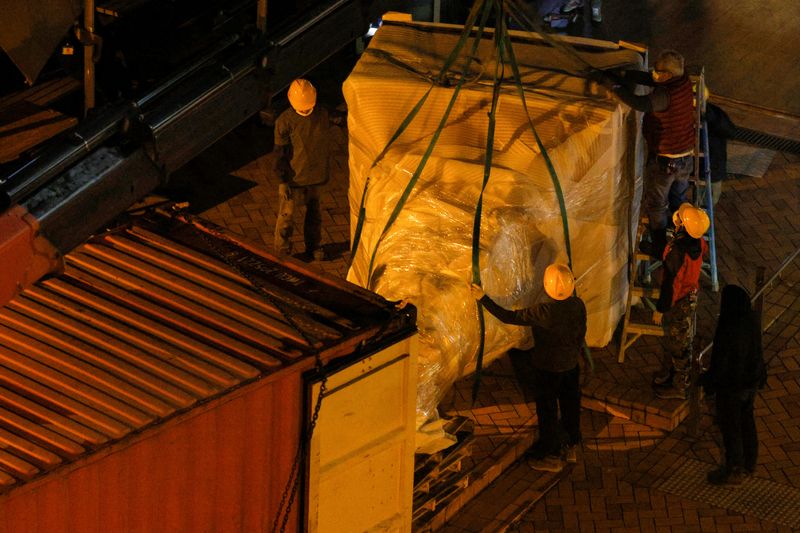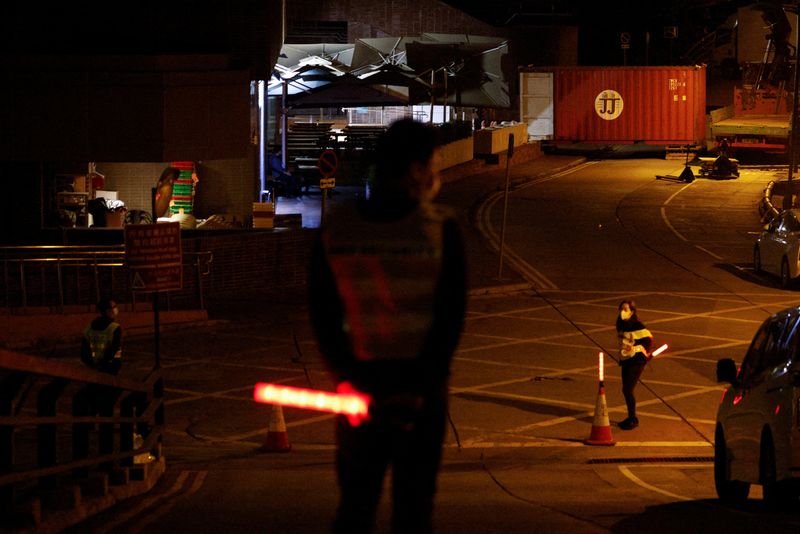HONG KONG (Reuters) – A leading Hong Kong university has dismantled and removed a statue from its campus site that for more than two decades has commemorated pro-democracy protesters killed during China’s Tiananmen Square crackdown in 1989.
The artwork, of anguished human torsos, is one of the few remaining public memorials in the former British colony to remember the bloody crackdown that is a taboo topic in mainland China, where it cannot be publicly commemorated.
Known as the “Pillar of Shame,” the statue was a key symbol of the wide-ranging freedoms promised to Hong Kong at its 1997 return to Chinese rule, which differentiated the global financial hub from the rest of China.
The city has traditionally held the largest annual vigils in the world to commemorate the Tiananmen Square crackdown.
The Council of the University of Hong Kong (HKU) said in an early Thursday statement it made the decision to remove the statue during a Wednesday meeting, “based on external legal advice and risk assessment for the best interest of the University”.
“The HKU Council has requested that the statue be put in storage, and that the University should continue to seek legal advice on any appropriate follow up action,” it said.
Late on Wednesday night, security guards placed yellow barricades around the eight-metre (26-foot) high, two-tonne copper sculpture.
Two Reuters journalists saw scores of workmen in yellow hard hats enter the statue site, which had been draped on all sides by white plastic sheeting and was being guarded by dozens of security personnel.
Loud noises from power tools and chains emanated from the closed off area for several hours before workmen were seen carrying out the top half of the statue and winching it up on a crane towards a waiting shipping container.
A truck later drove the container away early on Thursday. The site of the statue was covered in white plastic sheets and surrounded by yellow barricades. University staff later placed pots of Poinsettia flowers, a popular Christmas decoration in Hong Kong, around the barricades.
‘MEMORIES WRITTEN WITH BLOOD’
Several months ago, the university had sent a legal letter to the custodians of the statue, a group which organised the annual June 4 vigils and has since disbanded amid a national security investigation, asking for its removal.
A June 4 museum was raided by police during the investigation and shut, and its online version cannot be accessed in Hong Kong.
Danish sculptor Jens Galschiot, who created the statue, said in a statement he was “totally shocked” and that he would “claim compensation for any damage” to his private property.
Galschiot, who values the statue at around $1.4 million, had offered to take it back to Denmark, but said his presence in Hong Kong was necessary for the complex operation to go well and asked for reassurances he would not be prosecuted.
HKU said in its statement that no party had ever obtained approval to display the statue on its campus and that it had the right to take “appropriate actions” any time. It also called the statue “fragile” and said it posed “potential safety issues.”
Tiananmen survivor Wang Dan, who now lives in the United States, condemned the removal in a Facebook post as “an attempt to wipe off history and memories written with blood.”
The campus was quiet early on Thursday, with students on holiday. Some students dropped by the campus overnight after hearing the news.
“The university is a coward to do this at midnight,” said 19-year-old student surnamed Chan. “I feel very disappointed as it’s a symbol of history.”
Another student surnamed Leung said he was “heart-broken” to see the statue “being cut into pieces”.
TIANANMEN ERASED
The removal of the statue is the latest step targeting people or organisations affiliated with the sensitive June 4, 1989, date and events to mark it.
Authorities have been clamping down in Hong Kong under a China-imposed national security law that human rights activists say is being used to suppress civil society, jail democracy campaigners and curb basic freedoms.
Authorities say the law has restored order and stability after massive street protests in 2019. They insist freedom of speech and other rights remain intact and that prosecutions are not political.
China has never provided a full account of the 1989 Tiananmen Square crackdown. Officials gave a death toll of about 300, but rights groups and witnesses say thousands may have been killed.
“What the Communist Party wants is for all of us to just forget about this (Tiananmen). It’s very unfortunate,” John Burns, a political scientist at the university for over 40 years who had called for the statue to remain, told Reuters.
“They would like it globally to be forgotten.”
(Additional reporting by Sara Cheng, Alun John, Eduardo Baptista and Marius Zaharia; Writing by James Pomfret and Marius Zaharia; Editing by Sonya Hepinstall and Michael Perry)






























